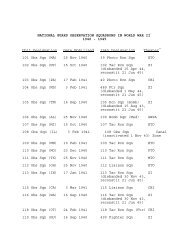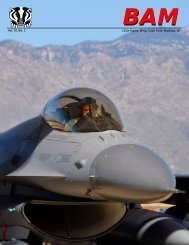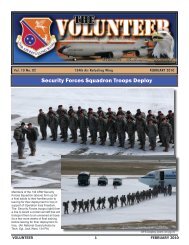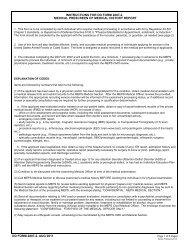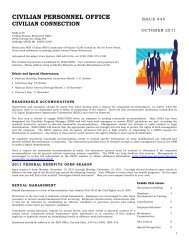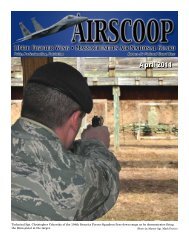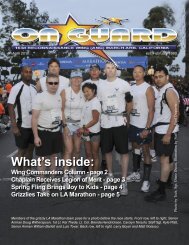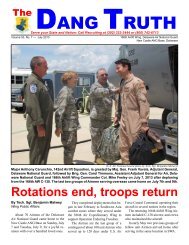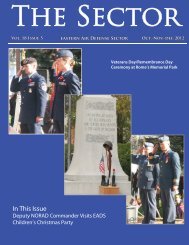March 2012 - 104th Fighter Wing, Massachusetts Air National Guard
March 2012 - 104th Fighter Wing, Massachusetts Air National Guard
March 2012 - 104th Fighter Wing, Massachusetts Air National Guard
- No tags were found...
You also want an ePaper? Increase the reach of your titles
YUMPU automatically turns print PDFs into web optimized ePapers that Google loves.
MARCH <strong>2012</strong>AIRSCOOPLooking for a few good men and women!By Sandra Wakefield, <strong>104th</strong> FW <strong>Air</strong>men and Family Readiness CenterPAGE 9HUSBANDS, WIVES, FA-THERS, MOTHERS,BROTHERS, SISTERS,FIANCE’S, GRANDPAR-ENTS, RETIREESBECOME A MEMBER OF THE 104 THFAMILY READINESS GROUPWe are expanding the board andneed your help!VOLUNTEER to be active in your ServiceMembers FRGVOLUNTEER as much or as littletime as you can, but volunteer!We host many fun events each yearand are looking for new ideas and newenergy!Attend our annual all expense paidweekend training at the Southbridge Hoteland Conference Center April 27 -29.Offers excellent workshops and an opportunityto network with other <strong>Guard</strong> familiesacross the state.An informative and fun time.We have a busy upcoming year. Younever know when our members will becalled. Help us to be there for them andall base families.Being involved with your FRG is agreat way to meet new friends and feelgood about making a difference.Elections for FRG BoardPositions:ChairpersonTreasurerSecretaryYouth Co-CoordinatorBoard MemberBoard MemberBoard memberWANTEDWe are also looking for a NewsletterEditor an individual whowould be interested in contributingan article ofFRG events and newsquarterly to the <strong>Air</strong> Scoop.Nominations submittedvia email by <strong>March</strong> 8.To FRG Secretarylyn@valleymarketing.netNames of nominees will be emailed on<strong>March</strong> 9Votes may be sent via email to theaddress above by <strong>March</strong> 14Elections to be held Thursday 15<strong>March</strong>Time: 4-6 p.m.Place: NCO ClubVotes to be counted day of elections.Please Get Involved … help us makethis the best year ever!Core training without back painBy Staff Sgt. Ryan Crossman, <strong>104th</strong> FW Logistics Readiness SquadronFor many of us, the term ―core training‖brings to mind the dread associated withdoing crunches in preparation for the <strong>Air</strong>Force Physical Fitness Test (AFPFT).However, traditional abdominal exercises,such as crunches and sit-ups, actuallypromote lower back pain due to repeatedand excessive flexion of the lumbar spine.Low back pain is a leading cause of disabilityin the US military ¹. So, how canwe strengthen our core AND reduce therisk to our lower backs? First, we need abasic understanding of what the coreactually is.Our ―core‖ is actually a collectionof muscles that primarily work to stabilizeour lumbo-pelvic-hip complex (ourcenter of gravity). These muscles includenot only the abdominals, but also thespinal erectors, glutes, hamstrings, andhip flexors, to name a few. The foundationof all human movement originatesfrom this area, so it makes sense that ourcore muscles are among the largest andstrongest in the human body. Without astrong core, the body cannot efficientlysupport the spine and transmit force tothe extremities.Advancements in biomechanicshave led many to re-evaluate the mannerin which they train the core. Dr StuartMcGill, an internationally recognizedexpert on spine function and injury prevention,has stated that the spine losesup to 40% of its ability to bear compressiveloads when fully flexed. A traditionalcrunch or sit-up can generate at least3,350 newtons of compressive force onthe spine. By comparison, the U.S. <strong>National</strong>Institute for Occupational Safetyand Health states that anything above3,300 newtons is unsafe. In light of thesefindings, a 2009 study of over 2,000 USArmy soldiers compared the effects of situpswith back-friendly core stabilizationexercises on performance in the USArmy‘s physical fitness test¹. The researchersfound that soldiers who performedcore stabilization exercises hadfewer days of work restriction due to lowback injury. Furthermore, the core stabilizationexercises were more effectivethan sit-ups in improving passing rateson the sit-up component of the test.The safest, most effective way totrain the core involves performing exercisesthat require the individual to maintaina neutral spine. This ensures thatthe lower back is in its strongest position.An isometric front plank is a great exampleof an exercise that trains the core tomaintain a neutral spine because if youdon‘t, the spine extends as the hips dropto the floor. There are countless ways toincorporate these concepts into any exerciseprogram.Everyone could greatly benefitfrom adopting this approach to coretraining. Although we can‘t escape theinevitability of doing crunches for theAFPFT, we should be smart about ourpreparation in the meantime. MarkTwain said it best – ―If you do whatyou‘ve always done, you‘ll get whatyou‘ve always gotten.‖ I can be reached atryan.crossman.1@ang.af.mil if you haveany questions, comments, or would likeme to show you any of these methods ingreater detail.Effects of Traditional Sit-up TrainingVersus Core Stabilization Exercises onShort-Term Musculoskeletal Injuries inUS Army Soldiers: A Cluster RandomizedTrial.http://www.ncbi.nlm.nih.gov/pubmed/19812508Ryan Crossman earned a masters degreein exercise science from Springfield Collegeand has been a strength and conditioningcoach to collegiate and highschool athletes for the past five years. Heis a Certified Strength and ConditioningSpecialist through the <strong>National</strong> Strengthand Conditioning Association.





